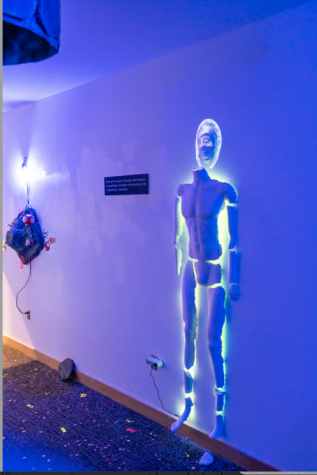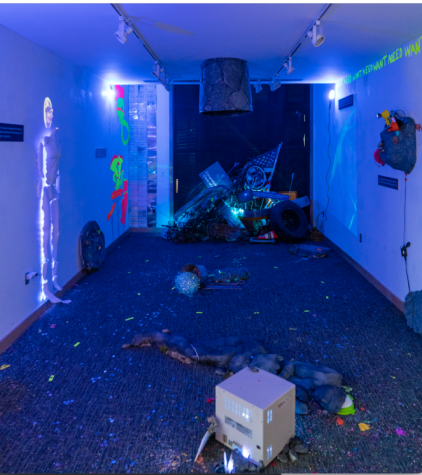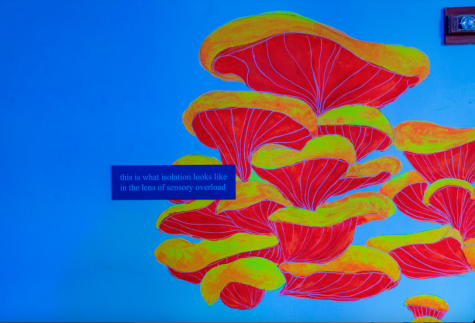Fi Black confronts isolation and technology in “wishing you well”
May 6, 2021

Close your eyes and imagine yourself descending into the dark depths of a wishing well. As the light from the sun fades and water begins to fill your ears, you find yourself surrounded by the physical debris of past relationships, lost loved ones and impending final exams.
In their brand new Stevens Gallery exhibit “wishing you well,” junior art major Fi Black (he/she/they) casts a vibrant, electric glow on the junk left behind by a year plagued with longing, loss and technological self-medication.
Black’s exhibit was born when she was encouraged to create something for the Stevens Gallery by student curator Elie Flanagan. Combining his background in motion graphics with a love for expressive, maximalist art, Black drew inspiration from a piece they created during the spring of 2020 called “Distintimacy” — a functional sculpture allowing anyone the freedom of intimacy through layers of plastic wrap.
“wishing you well” not only borrows the underlying theme from its spiritual predecessor about COVID-19 isolation, but demands participation in much the same way. The guest book brims with wishes, written in countless languages. A carton of confetti-filled eggs sits waiting patiently to be hurled. There are no signs that demand guests keep their hands off the artwork.
According to Black, the concept of the wishing well was inspired by the fact that casual acquaintances stopped existing once the whole world retreated into quarantine.
“Like, damn, I just feel so forlorn, and I wish a lot of people well,” Black said, describing her general headspace when the pandemic began. “And I was, like, oh! A wishing well! And then I was, like, what if we were inside a wishing well? And what if it’s all blue? And what if there’s me crying on the thing? And rocks everywhere? And what if it was, like, a junkyard?”
As all of these elements began to coalesce, it became clear to Black that the exhibit’s underlying message pointed to our collective need to use technology to survive a year where we all missed out and experienced loss.
“I kind of put that [theme] with childhood, with lost objects, junk, to conjure… that lost feeling, that forlornness, and channel that into the perspective of, now what if all of this stuff had an electric heartbeat? Like, all this dormant, stagnant stuff, the only thing keeping it alive is the lights, the technology.”
Black also wanted the exhibit to somehow alter every detail of physical space. He selectively covered the letters in “Stevens Gallery” to say “See All.” They scrawled, “They don’t like what’s inside” on the gallery’s glass doors.

“If I could, I would put plastic all over the floor and fill it ankle-deep with water,” she said.
This yearning for total transformation stemmed in part from the fact that Reid Campus Center, where the gallery is housed, has undergone many changes since the pandemic began. What was once a bustling social hub has become virtually uninhabited.
Black wanted to create a space within Reid that would bring some of that liveliness back, while still staying consistent with his theme of technological dependence.
“You’re only alive because of your phone! Because of Netflix! And now you feel like this petrified stone!” they said.
Somewhat paradoxically, the exhibit is also meant to be a space for safety and acceptance, where expression and interactivity are encouraged. Black is heavily involved with Whitman’s annual Rocky Horror Show, which she describes as a place where queer Whitties can be unapologetically expressive and sexual without fear of judgement. Similar to Rocky Horror, “wishing you well” is meant to belong to the viewers just as much as it belongs to Black.
“If you go in a gallery, with the podiums and the fucking pictures, it’s like looking at a picture of a sculpture. A picture of a sculpture is much different than looking at a sculpture. A picture of this exhibit is much different than being in the exhibit, getting to touch the things in the exhibit, because you’re not allowed to touch things. But this is like, it’s your space! I just wanted people to be able to be inside somewhere, and it’s like, yes, you’re allowed to be here. Nowhere else on campus is like this.”
To junior Elie Flanagan, who is the gallery’s student intern and curator, it was clear from the start that the exhibit was going to be unlike any she’d ever organized. She sees the exhibit as a response to a year marked by strange new divisions, new rules and new chaos.
“I think it’s an externalization of a very Fi Black experience of that,” Flanagan said. “Fi’s the kind of person where if they sink their teeth into an idea, it’ll be big and funky and really cool. They’ve been working on making the pieces for basically this whole semester, and it’s just such an extreme labor of love.”
Black’s advisor, Associate Professor of Art Nicole Pietrantoni, said that it has been exciting to see the show come together. She hopes everyone on campus gets the chance to experience it before it is taken down later this year.

“Fi has an immense work ethic, drive and vision… I can say that if I stepped into the gallery and didn’t know the maker, I would see someone deeply committed to the process of artmaking, taking risks and experimenting with materials,” Pietrantoni said.
For Black, his most fervent hope is that people continue to engage with the exhibit and leave wishes and comments in the guest book. They hope to create, in a sense, a communal 2020 yearbook.
“It’s just this human experience. Everyone lost something. Everybody’s missing out. Everybody’s experiencing some kind of hurt, or loss or lost feeling. I feel like I look in the mirror, and I don’t know who I fucking am. And I don’t know what happened, or when that happened, or what personality changed, or what event. It’s just something I’ve noticed, and I just wanted to capture those things… Everything I put in there, there’s intention and it makes sense. Even if I didn’t really intend it to be there when I was installing it, there’s an intention behind it that I can completely support, because that was the process.”
“wishing you well” will be on display in the Stevens Gallery throughout the summer.





